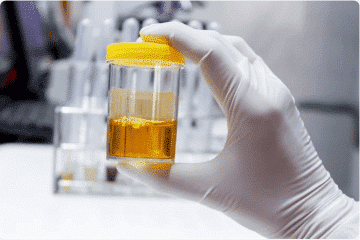Have you ever heard of microscopic urine analysis? This is a urine test that is done with a microscope, and now where do the epithelial cells in urine fit in all this?
The microscopic examination of urine can also be called the epithelial cells in urine test. Now, what are these epithelial cells in urine all about? Is it dangerous? Can it be treated? Do I have it? And so on, the questions keep piling in, but don’t worry, Healthsoothe is here for you as usual.
This article aims to expose all there is to know about epithelial cells in urine, the epithelial cells in urine test, and other important things you need to know on this topic.
Alright, we move.
- Epithelial Cells in Urine – What are they?
- What is an Epithelial Cells in Urine Test?
- What is the Epithelial Cells in Urine Test used for?
- What Occurs During Epithelial Cells in Urine Test?
- Is There Anything You Need to Do to Prepare for the Epithelial Cells in Urine Test?
- Is There Any Danger in the Epithelial Cells in Urine Test?
- Why Do You Need Epithelial Cells in Urine Tests?
- What do the Results of the Epithelial Cells in Urine Test imply? – Interpreting the Results of an Epithelial Cells in urine Test
- Risk Factors for Increased Epithelial Cells in Urine
- Treatment of the Underlying Issue Associated with Epithelial Cells in Urine
- How to Prevent High Epithelial Cells in Urine
- The Outlook
Epithelial Cells in Urine – What are they?

Epithelial cells are the cells that coat the interior and exterior of your body's surfaces. They may be located on the skin, blood vessels, and organs such as your urinary system.
Types of Epithelial Cells in Urine
The appearance, size, shape, and epithelial cells vary. Depending on their origin, there are three kinds of epithelial cells that may be identified in your urine:
- Renal tubular or columnar epithelial cells: These epithelial cells are the most significant. A high number may indicate a renal problem. They are also known as renal cells.
- Squamous epithelial cells: This is the widest variety. They originate in the vagina and urethra. This is the most common kind discovered in female urine.
- Transitional epithelial cells: They may enter the body from any location in between the male urethra and the renal pelvis. They're also known as bladder cells and are more frequent in elderly people.
What is an Epithelial Cells in Urine Test?

Epithelial cells in urine test determines the number of epithelial cells in urine by examining your urine specimen under a microscope. It is typical for urine to include a modest number of specific kinds of epithelial cells.
A high quantity might mean you have an infection of the urinary tract, renal illness, or another dangerous medical issue.
Other names for epithelial cells in urine include microscopic urine analysis, microscopic urine examination, urine analysis, urine test, and UA.
To know more on epithelial cells in urine, watch the video below:
What is the Epithelial Cells in Urine Test used for?
An epithelial cells in urine test is urinalysis1Mayo Clinic [Internet]. Mayo Foundation for Medical Education and Research; c1998–2022. Urinalysis; [cited 2022 Mar 3]; [about 7 screens]. Available from: https://www.mayoclinic.org/tests-procedures/urinalysis/about/pac-20384907, which detects several chemicals in your urine. It might be part of a routine check-up, or your doctor may request it if you show indications of a bladder or urinary tract disease.
A urinalysis may involve a visual inspection of urine samples, chemical testing, and analysis underneath a microscope to search for certain kinds of cells. A urine epithelial cells test is a part of a microscopic examination of urine.
What Occurs During Epithelial Cells in Urine Test?
You will be required to provide a urine sample for the test. A health care expert may provide you with a cleaning wipe, a tiny container, plus instructions for collecting your urine sample using the "clean catch" approach. It's critical to follow these steps to avoid introducing pathogens from your skin into the sample:
- Wash and dry your hands using soap and water.
- Without touching the interior of the container, open it.
- Use the cleaning wipe to clean your genital area:
- For the penis: Wipe the whole tip (end) of the penis with the cleaning wipe to clean your genital region. Pull your foreskin back initially if you have one.
- For the vagina: Spread the labia (the skin folds surrounding the vagina) and clean the inside sides from the front to back.
- Urinate for brief seconds into the toilet before stopping the flow. Begin urinating once again, this round into the container. Don't allow the container to come into contact with your skin.
- Fill the jar with at least a minimum of an ounce/two of pee. The container should be labeled with the amount of pee required.
- Complete your urination in the toilet.
- Replace the container's cap and deliver it as directed.
Inform your doctor before your test if you have bleeding hemorrhoids or are experiencing your menstrual period.
Is There Anything You Need to Do to Prepare for the Epithelial Cells in Urine Test?
There are no extra preparations required for the exam. If your doctor has ordered further blood and urine tests, you may be required to go under a fast (not consume food or drink) for several hours before the test. If there are any particular instructions to follow, your provider will notify you.
Is There Any Danger in the Epithelial Cells in Urine Test?
There is no recognized danger in getting the test.
Why Do You Need Epithelial Cells in Urine Tests?
If the findings of your visual or chemical urine tests were abnormal, your physician may have requested an epithelial cells in urine test as an aspect of your routine checkup. This test may also be required if you have signs of a urinary tract or renal disease. Among these signs are:
- Urination that is frequent and/or uncomfortable
- Pain in the abdomen
- Back ache
What do the Results of the Epithelial Cells in Urine Test imply? – Interpreting the Results of an Epithelial Cells in urine Test
The results are often presented as a total number, such as "few," "moderate," or "many" cells. A typical outcome is "few" cells.
The presence or absence of epithelial cells in urine is often stated as follows:
- Few: When three or fewer epithelial cells are detected in a high-powered field
- Moderate: When 4 to 10 epithelial cells are visible in a high-power field
- Many: When 10 or more epithelial cells are detected in a high-powered field.
Most of the time, epithelial cells in urine have little clinical significance. However, this data must be interpreted in conjunction with other urine characteristics such as the existence of mucus, germs, and cell morphologies.
"Moderate" as well as "many" cells might indicate a medical condition such as:
- Infection of the urinary tract
- Infection with yeast
- Kidney failure
- Disease of the Liver
- Cancers of certain kinds
Certain disorders may also be indicated by the kind of epithelial cells seen in urine. For example, epithelial cells with a high concentration of hemoglobin or blood particles may indicate that you previously had hemoglobin or red blood cells in your urine, even if they were not present during the urinalysis.
Over 15 renal tubular epithelial cells for each HPF may indicate that your kidney is malfunctioning. Squamous epithelial cells in urine might simply indicate that the sample is tainted.
A urinalysis that reveals squamous epithelial cells in the urine is unusual, according to William Winter, MD, a clinical chemist at Shands Hospital and a professor of pediatrics and pathology at the University of Florida. This is because the clean catch technique of acquiring a urine sample typically avoids the presence of squamous epithelial cells in the urine.
You will be provided a sterilizing towel to cleanse the region surrounding the penis or vagina before submitting your urine sample when utilizing the clean catch method. This prevents impurities from your skin, such as epithelial cells, from appearing in your sample.
Your doctor can assist you in understanding your test findings and determining if you have a health problem that requires treatment. Further tests may be ordered by the doctor to determine the reason.
If your findings are out of the ordinary, it does not automatically imply that you suffer from a health issue that requires treatment. More testing may be required before your clinician can establish a diagnosis. Speak with your provider to find out what your findings signify.
Related Conditions Associated with High Epithelial Cells in Urine – Causes of High Epithelial Cells in Urine
An increased number of epithelial cells in the urine may indicate one of the following conditions:
Urinary tract infection
Regular exercise may help a person manage their kidney disease symptoms.
There are three types of urinary tract infection (UTI). They each affect a different part of the urinary tract:
- Cystitis: This is a UTI that affects the bladder.
- Urethritis: This is a UTI that affects the urethra.
- Kidney infection: This is a UTI that affects the kidneys.
Symptoms of a UTI include:
- frequent or urgent need to urinate
- pain or burning sensation when urinating
- cloudy or smelly urine
- blood in urine
- pain in lower abdomen
- feeling tired or unwell
Doctors typically prescribe antibiotics or antiviral medication to treat UTIs.
Menopause
Women who are postmenopausal and have low estrogen levels may have a larger number of epithelial cells in their urine. It does not, however, indicate that such women are at a greater risk of sickness, nor does it create symptoms. Women who feel they are menopausal should have their hormone levels evaluated and, if required, begin hormone replacement treatment.
Yeast infection
Yeast is a natural fungus. Every woman has a small amount of yeast in her vagina. Changing hormone levels or taking antibiotics may change the balance of bacteria in the vagina. As a result, yeast may grow more than usual and lead to a yeast infection.
Symptoms of a yeast infection include:
- itching or soreness in the vagina
- pain or burning when urinating or having sex
- thick or clumpy white discharge
Treatments for yeast infections include antifungal tablets, cream, or a suppository.
Kidney disease
Kidney disease is a long-term condition where the kidneys do not work as well as they should.
The risk of kidney disease increases with age. Other risk factors include:
- kidney stones
- a weak immune system
- diabetes
- high blood pressure
- a family history of kidney disease
- an enlarged prostate
There is no cure for kidney disease, but the following treatments may help a person manage their symptoms:
- following a healthful diet
- exercising regularly
- drinking less alcohol
- quitting smoking
- taking medication to control blood pressure and cholesterol
- undergoing kidney dialysis
- having a kidney transplant
Liver disease
There are some different types of liver disease. These include:
- alcohol-related liver disease
- non-alcoholic fatty liver disease
- hepatitis
- hemochromatosis
- primary biliary cirrhosis
Symptoms of liver disease include:
- extreme tiredness or weakness
- loss of appetite
- loss of libido or reduced sex drive
- jaundice
Treatment for liver disease depends on the cause. If the disease is caused by excess alcohol consumption, a doctor will help a person seek support to stop drinking.
Bladder cancer
Bladder cancer occurs when abnormal tissue grows in the bladder lining. It is the fourth most common cancer2National Cancer Institute [Internet]. Bethesda (MD): U.S. Department of Health and Human Services; NCI Dictionary of Cancer Terms; epithelial [cited 2022 Mar 3]; [about 1 screens]. Available from: https://www.cancer.gov/publications/dictionaries/cancer-terms/def/epithelial in men in the United States.
Bladder cancer may cause an increased amount of epithelial cells in urine. However, it is important to remember that this alone does not indicate cancer.
Symptoms of bladder cancer include:
- streaks of blood in the urine that may turn the urine brown
- frequent urges to urinate
- sudden urges to urinate
- burning sensation when urinating
- pelvic pain
- bone pain
- unexpected weight loss
- swelling in the legs
There are many surgical and non-surgical treatments available for bladder cancer. A team of healthcare workers will help an individual with bladder cancer determine the best treatment plan for them.
Risk Factors for Increased Epithelial Cells in Urine
You are more likely to have high epithelial cell numbers if you:
- suffer from kidney stones
- have a compromised immune system, diabetes, or high blood pressure
- have a history of chronic renal disease in your family
- are of Hispanic, Asian, African, or American Indian origin and have an enlarged prostate
Treatment of the Underlying Issue Associated with Epithelial Cells in Urine

The treatment will be determined by the reason for the abnormally high amount of epithelial cells in urine. The majority of UTIs are microbial bacteria and may be treated with antibiotics. Drinking extra water might also help you recuperate faster. Antivirals are medications that physicians may give for viral UTIs.
Treatment for kidney illness includes controlling the disease's underlying cause, such as blood pressure, blood sugar, and cholesterol levels. Even if you do not have high blood pressure, your doctor may recommend a blood pressure medicine to reduce the course of the condition or maintain kidney function. Changes in diet and lifestyle are also crucial.
Your doctor may recommend that you:
- managed diabetes with insulin injections
- reduce your intake of high-cholesterol meals
- reduce sodium intake boost physical activity limit alcohol
- slim down
- begin a heart-healthy diet of fresh fruits, veggies, and whole grains
- stop smoking
How to Prevent High Epithelial Cells in Urine
Hydration is one of the simplest ways to avoid urinary tract infections and kidney problems. You should drink many glasses of water every day, but consult with your doctor to determine what is best for you.
Cranberry juice and cranberries may help reduce the chance of having UTIs. Cranberries include a substance that may protect your bladder lining against bacteria attachment. However, there is still controversy in the medical world concerning the effectiveness of this therapy.
The Outlook
The urinary tract is lined by three kinds of epithelial cells: Squamous cells, transitional cells, renal (kidney) tubular or columnar cells and are all names for these cells.
If you find squamous epithelial cells in your urine, it might indicate that your sample was contaminated. This indicates that the sample includes cells from elsewhere in the body. This may occur if you do not thoroughly clean your genital region before collecting the urine sample using the clean catch technique.
If a urinalysis reveals epithelial cells in urine, this is usually not reason for concern.3Urinalysis: Three types of examinations. (n.d.). labtestsonline.org/understanding/analytes/urinalysis/ui-exams/start/2 It might be the consequence of a tainted sample. Epithelial cells in urine may also identify underlying diseases such as a urinary tract infection or a kidney ailment.
Only the doctor can interpret the findings of your tests and advise you on the best action to take. Even so, more testing may be required.
All right, guys, that is it for now for epithelial cells in urine. I hope Healthsoothe answered any questions you had concerning epithelial cells in urine.
Feel free to contact us at contact@healthsoothe.com if you have further questions to ask or if there’s anything you want to contribute or correct to this article. And don’t worry, Healthsoothe doesn’t bite.
You can always check our FAQs section below to know more about epithelial cells in urine. And always remember that Healthsoothe is one of the best health sites out there that genuinely cares for you. So, anytime, you need trustworthy answers to any of your health-related questions, come straight to us, and we will solve your problem(s) for you.
Frequently Asked Questions Related to Epithelial Cells in Urine
What is the Normal Range of Epithelial Cells in Urine?
The normal value of squamous epithelial cells present in the urine sample is approximately less than or equal to 15 – 20 cells per high power field (HPF).
What does Epithelial Cells Positive Mean?
If there are more than the specified number of epithelial cells in your urine test, it indicates the presence of any of the following conditions: Urinary tract infections, such as: Urethritis (urethral infection) Cystitis (urinary bladder infection) Kidney infection.
Does Epithelial Cells in Urine Mean Infection?
It's normal to have a small number of certain types of epithelial cells in urine. A large number may indicate a urinary tract infection, kidney disease, or other serious medical condition.
I Am odudu abasi a top-notch and experienced freelance writer, virtual assistant, graphics designer and a computer techie who is adept in content writing, copywriting, article writing, academic writing, journal writing, blog posts, seminar presentations, SEO contents, proofreading, plagiarism/AI checking, editing webpage contents/write-ups and WordPress management.
My work mantra is: “I can, and I will”
Additional resources and citations
- 1Mayo Clinic [Internet]. Mayo Foundation for Medical Education and Research; c1998–2022. Urinalysis; [cited 2022 Mar 3]; [about 7 screens]. Available from: https://www.mayoclinic.org/tests-procedures/urinalysis/about/pac-20384907
- 2National Cancer Institute [Internet]. Bethesda (MD): U.S. Department of Health and Human Services; NCI Dictionary of Cancer Terms; epithelial [cited 2022 Mar 3]; [about 1 screens]. Available from: https://www.cancer.gov/publications/dictionaries/cancer-terms/def/epithelial
- 3Urinalysis: Three types of examinations. (n.d.). labtestsonline.org/understanding/analytes/urinalysis/ui-exams/start/2
The content is intended to augment, not replace, information provided by your clinician. It is not intended nor implied to be a substitute for professional medical advice. Reading this information does not create or replace a doctor-patient relationship or consultation. If required, please contact your doctor or other health care provider to assist you to interpret any of this information, or in applying the information to your individual needs.


